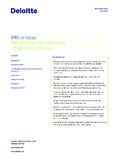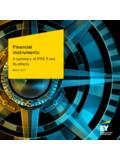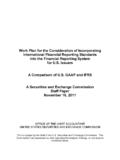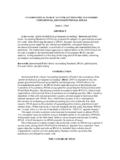Transcription of Leases A guide to IFRS 16 - Deloitte US | Audit ...
1 LeasesA guide to ifrs 16 June 2016 This guide contains general information only, and none of Deloitte Touche Tohmatsu Limited, its member firms, or their related entities (collectively, the Deloitte Network ) is, by means of this guide , rendering professional advice or services. Before making any decision or taking any action that might affect your finances or your business, you should consult a qualified professional adviser. No entity in the Deloitte Network shall be responsible for any loss whatsoever sustained by any person who relies on this guide . 2016. For information, contact Deloitte Touche Tohmatsu from International financial Reporting Standards and other International Accounting Standards Board material are reproduced with the permission of the ifrs guide is intended to assist preparers and users of financial statements to understand the impact of ifrs 16 Leases , issued in January 2016 and effective for accounting periods beginning on or after 1 January begin with a high-level executive summary of the new requirements, followed by a specific focus on the important issues and choices available for entities on transition to the new Standard.
2 Our detailed guide covers the requirements of the new Standard, supplemented by interpretations and examples to give clarity to those requirements, and pointers regarding practical issues that are likely to arise. In the appendices, we provide: a summary of the important illustrative examples accompanying ifrs 16 dealing with the identification of Leases ; convenient checklists for ifrs 16 s presentation and disclosure requirements (separately for lessees and lessors); and a brief comparison with US Generally Accepted Accounting Principles (US GAAP).We trust that you will find this guide informative and a useful reference the detailed guide , paragraphs that represent the authors interpretations, material drawn from the IASB s Basis of Conclusions on ifrs 16, and examples other than those cited in IFRSs are highlighted by green | A guide to ifrs 16 ContentsExecutive summary 3 Dealing with transition 5 Detailed guide 9 Appendices Appendix 1 Illustrative examples identification of a lease 97 Appendix 2 Presentation and disclosure checklist lessees 102 Appendix 3 Disclosure checklist lessors 107 Appendix 4 Comparison with US GAAP 1092 Leases | A guide to ifrs 16 Executive summary ifrs 16 Leases was issued by the IASB in January 2016.
3 It will replace IAS 17 Leases for reporting periods beginning on or after 1 January 2019. It can be applied before that date by entities that also apply ifrs 15 Revenue from Contracts with Customers. ifrs 16 sets out a comprehensive model for the identification of lease arrangements and their treatment in the financial statements of both lessees and lessors. ifrs 16 applies a control model for the identification of Leases , distinguishing between Leases and service contracts on the basis of whether there is an identified asset controlled by the customer. While, for the majority of contracts, the classification under the new Standard as either a lease or a service contract may not be different to the classification under the IAS 17 risks and rewards model, divergence may emerge, for example, when the pricing of the contract was a significant consideration under IAS 17.
4 Importantly, both lessors and lessees are entitled to grandfather assessments regarding whether a contract existing at the date of initial application of ifrs 16 contains a lease so that entities are not required to incur the costs of detailed of the most notable aspects of ifrs 16 is that the lessee and lessor accounting models are asymmetrical. While the IASB has retained IAS 17 s finance lease /operating lease distinction for lessors (and carried into ifrs 16 the related requirements virtually intact), the distinction is no longer relevant for lessees. For lessors, the changes introduced by ifrs 16 are not significant and, except in respect of subleases, a lessor is not required to make any adjustments on transition for Leases in which it is a lessor. Additional requirements have been introduced for subleases and lease modifications, and lessor disclosure requirements have been expanded.
5 For lessees, the picture is fundamentally different and ifrs 16 can be expected to have a significant impact, particularly for entities that have previously kept a large proportion of their financing off-balance sheet in the form of operating Leases . This operating lease -style accounting treatment is no longer available, except for short-term Leases ( lease term 12 months or less) and Leases of low-value assets ( low value is not specifically defined but the IASB has indicated that it has in mind assets with a value, when new, in the order of magnitude of US$5,000 or less).All other Leases within the scope of ifrs 16 are required to be brought on-balance sheet by lessees recognising a right-of-use asset and the related lease liability at commencement of the lease , with subsequent accounting generally similar to the finance lease model under IAS these new requirements affect a lessee s financial statements will obviously depend on the mix of lease agreements in place, and also on which of the Standard s exceptions and practical expedients are applied.
6 However, the expectation for lessees will be: an increase in recognised assets and liabilities (right-of-use assets and liabilities recognised other than for short-term Leases and Leases of low-value assets); more lease expenses recognised in the early periods of a lease , and less in the later periods ( front-loaded finance charge on lease liability versus straight-line expense under IAS 17 s operating lease approach); a shift in lease expense classification from operating expenses to financing costs and amortisation ( moving below metrics such as operating profit, EBITDA or EBIT). There are some exceptions: any variable lease payments not included in the initial measurement of the lease liability are classified as operating expenses, as are the expenses associated with short-term and low-value asset Leases for which recognition exemptions are applied; and for entities that present cash flows related to interest on Leases as financing flows, a shift of the payments previously associated with operating Leases to the financing category (unless they change their policy regarding presentation of interest cash flows).
7 Cash from operations and financing activity outflows will both increase for these number of aspects of the application of ifrs 16 will require the exercise of judgement particularly in respect of the definition of a lease and the assessment of the lease term. Entities will also need to take time to consider whether to avail of practical expedients and recognition exemptions (including, in particular, reliefs available on transition, as discussed in detail in the next section of this guide ). In addition, there are important business considerations including whether changes are needed to systems and processes ( to track Leases individually or at a portfolio level, or to accumulate the information needed for disclosures); any potential tax impacts (if the treatment of a lease for tax purposes is based on its treatment in the financial statements).
8 And the impact of changes in the amounts reported on key metrics, debt covenants and management | A guide to ifrs 16 ifrs 16 Key judgements, policy choices and exemptions Detailed guide referenceJudgement: Identifying a lease will sometimes require a significant amount of judgement based on the elements of the definition of a leaseIdentifying a lease (section 3)Judgement: Determining whether it is reasonably certain that an extension or termination option will be exercisedLease term(section 5)Judgement: Identifying the appropriate rate to discount the lease payments may involve significant judgementDiscount rate(section )Exemption: Exemptions may be taken for short-term Leases (by class of asset) or low-value asset Leases ( lease -by- lease basis)Recognition(section )Policy choice: Requirements of ifrs 16 can be applied to a portfolio of similar Leases provided that such aggregation is not expected to have a material effectApplication to portfolios (section )Policy choice: Lessee may elect not to separate non- lease components from lease components by class of asset Components(section 4)Policy choice: Lessee may, but is not required to, apply ifrs 16 to Leases of intangible assetsScope(section 2)Policy choice: The transition choices available are.
9 Full retrospective approach or cumulative catch-up approach, definition of a lease choice to grandfather all or none, initial direct costs in measurement of right-of-use asset choice lease -by- lease , and other practical expedients on transitionTransition(section 11) 4 Leases | A guide to ifrs 1610 Key questions for management1. Do you know which of the entity s contracts are, or contain, Leases ?2. Are your systems and processes capturing all of the required information?3. Are systems and processes capable of monitoring Leases and keeping track of the required ongoing assessments?4. Have you considered the potential use of ifrs 16 s recognition exemptions and practical expedients?5. Do you know which transition reliefs are available, and whether you will apply any of them?6. Do you know what discount rates you will be using for your different Leases ?
10 7. Have you considered the impact of the changes on financial results and position?8. How will you communicate the impact to affected stakeholders?9. Have you planned when you will consider the tax impacts?10. Have you considered whether your leasing strategy requires revision?Although ifrs 16 is not mandatorily effective until periods commencing on or after 1 January 2019, for many entities the scale of the challenge ahead means that they will be starting to think about implementation sooner rather than later. For some, there will be technical accounting questions that require careful consideration but, for many, the primary challenge will be gathering the necessary data, ensuring that it is reliable and that systems are ready. This section of our guide highlights some of the primary considerations entities should have in mind as they begin to prepare for transition to ifrs to involve?

















